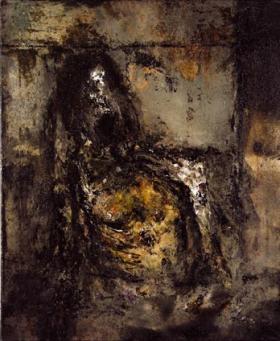Stani Nitkowski "Parcours"
To celebrate the fifth anniversary of Stani Nitkowski's death, a big monography was published by the Abbey of Auberive cultural centre (256 pages, texts by Philippe Dagen and Marcel Moreau). At the same time, three Parisian galleries - Vanuxem, idées d'artistes and Sellem - organised three exhbitions to show the curse of this great artist.
Stani Nitkowski,
His life, written with black ink, infinitely drawn, incised, names the hard desire to exist. In one of his intimate diaries, he says: "Miscellaneous :on this day of May 1949, the 29 to be more precise, I was, at the crossroads of existence, mown by death as I was about to rove on the edge of life, the ditches then became the bed to rest my body on ". And many pages further, " the law of most dead is always the watcher " (spoonerism from the French “La loi du plus mort est toujours le veilleur”). As a biography, no more needs to be said. Stani Nitkowski, born on the smoking debris of the Second World war, will commit suicide, at the beginning of the century, April 2, 2001. Son of a miner father of Polish extraction, he will have lived from the age of 23 nailed in a wheelchair, following a myotonic dystrophy. By compassion, one offers him an occupation, tubes of colours, pencils and paper, which leads him to show his work, in 1973, for the first time in a supermarket, then to meet Robert Tatin, baker, geometrician, sculptor and builder patriarch of Outsider Art. Each one helps the other, Tatin advises the young invalid to escape, to lay down on a paper bed the dead load : “draw, draw and you will see more clearly”. But let us not confuse this filiation, Nitkowski is not the epigone of an art circle called “Outsider ”, which is unaware of himself, federated by Jean Dubuffet. Autodidact, he seeks a spiritual family, devours the art books, pins postcards from everywhere in his workshop. And although he is received coldly by Dubuffet, who is distracted and elsewhere, he becomes the volcanic and enraged artist, scholar and brilliant, who will seduce the painter Corneille, the critic of art Jean-Marie Drot, the merchants Cérès Franco and Vanuxem, in Paris, and benevolent collectors. What they discover in echo is the history of a stimulating tragedy, which turns the obsession of death into an incredible novel of survival. Since 1981, Nitkowski makes his way alone, snatches the colours of Primitive Italians, the paste of Van Gogh, steals a little from Maryan, copies the heroic figures, creates a little circus, slightly pathetic and reveals his own art. Little by little, he invents his language by leaving the childhood of art. His paintings, from 1988, become more complex, superimposing in their composition the figures and the bodies of a gigantic and carnivorous farce, as the drawing imposes itself, by scratches and scars, in its pictorial work. It seems that the mark is used as a nerve, spinal column, blood and flux irrigating the large body that paint is. One is never far from automatic writing, of a exhilarating pulsation of an astonishing invention. This expressionist who is neither urban nor social, shows the chronicle of the body that disintegrates, of the body in fall, the body that levitates, or is wished for. This obstinate vitality, so off-hand in a time when abundance is suspect, results in hundreds of drawings, produces each day witty texts and even rarer and more ambitious paintings. With time, the work, in spite of a recognition due to many personal shows, seems to retract, entrust to the black the blackness of an exhausting dissatisfaction. Ultimate paintings, that converse with the blind light of Goya and quotes the destiny of Christ. His paintings have the colour of the ground. The materiality of ash. All becomes diffused, allegorical, basic, and yet increasingly tangible to all who want to see it : Nitkowski digs a bed of painting which seems like a shroud; and the shade that covers the clearness of its fabrics indicates the absence, the transfiguration, and perhaps the respite. A life, so confused, so absurd, so resistant, so merry and so disastrous. So true, also, of a man who writes, somewhere on a bit of paper, under the border of a drawing, these words: "Would this be a dream, dared, to confess, on the mouths, my hope to be..."
Laurent Boudier
